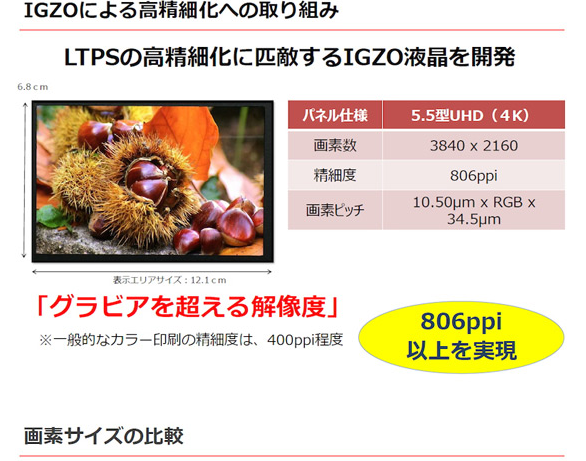Sharp's 4K Smartphone Display Highlights OEM Tradeoffs
Sharp announced today that it's going to manufacture the world's sharpest display, a 5.5" IGZO screen with a 4K/UHD 3840 x 2160 resolution. The display has a pixel density of 806 PPI and will arrive in devices in 2016. [Samsung is another company that promised to smartphones with 4K displays (Korean).]
Not long ago, even the prospect of having a Full HD resolution on an ~5" display seemed quite unbelievable. Now, some are disappointed that new flagship smartphones such as the HTC One M9 come with "only" a 1080p screen (something that HTC fixed in the HTC One M9+, although it won't be available for sale in the Western markets).
Although devices that are 1440p or even 4K will look even more stunning, there are indeed diminishing returns benefits-wise as the cost, the power consumption, or the GPU resources required to handle such high resolutions are significantly higher than the previous generations.
That's not to say that a 4K display today will necessarily cost more than a 1440p display did last year, but it does cost significantly more than a 1440p display being sold this year. Although the price ratios for components may remain relatively the same for the new technologies inside a new smartphone, if the benefits are increasingly smaller, then there's an opportunity cost, as well.
For instance, the extra cost to get a 4K display over a 1440p display this year could be used instead towards improving the device's camera. (OEMs could use a sharper lens, a larger sensor, improved OIS, and so on.) This sort of balance should always be taken into consideration.
Sometimes the competition among OEMs to "one-up" each other causes some monotony in the market. Consumers like to have "better" components every year, but that becomes quite predictable after a while, and consumers can become less interested in upgrading their phones.
What they like even more is having exciting new components, such as when Apple added Touch ID or when Samsung began offering curved displays on its phones.
Get Tom's Hardware's best news and in-depth reviews, straight to your inbox.
That doesn't mean higher resolution displays in smartphones are not useful. However, they could be even more useful for other applications; for example, 4K displays are ideal for VR. In order to have a VR experience that makes you completely forget you have a screen in front of your eyes, you'll need at least a 4K resolution screen.
Higher-resolution displays will also help lower the cost of lower resolution panels.There's another angle to the trend of higher-res displays to consider, though: If 4K displays become popular in high-end flagship devices, then 1440p and 1080p panels will be an even more common occurrence at the mid-range, while HD 720p displays should soon become the norm at the low-end -- even for devices that are less than $100 unsubsidized. And that's not a bad thing.
Follow us @tomshardware, on Facebook and on Google+.
Lucian Armasu is a Contributing Writer for Tom's Hardware US. He covers software news and the issues surrounding privacy and security.
-
Vidmantas Pakalniskis Interesting how in the same article author bashed HTC for M9 1080p display and after that counted the drawbacks for higher resolution...Reply -
TechyInAZ ReplySo there are already 5.5" 4K screens, but I still can't get a 24" 4K monitor?
There talking about other countries doing this like Korea. Korea is usually close to a year ahead of us technology wise. which is why they already are introducing 4k into the mainstream. -
ZolaIII I am actually glad they accomplished it as this will finally end ridiculous PPI race on smartphones as even those with best eye sight among us can't see even this much. To be honest with you 300 PPI is considered as a good photography quality what is exactly that 5"(4.8") 720p is delivering.Reply -
none12345 Depending on the usage, this is either stupid, or good.Reply
If its for a phone its dumb. Your eye cant see that many pixles, 1080p(or varients) are just about perfect for the distance you will hold a 5.5" screen phone. Even if it wasnt dumb for a phone, i wouldnt want it with current hardware, it would be too slow.
If we are talking a screen for a virtual headset tho, then 4k at that size is about what you need. Tho 3 inches from your eyes, you might need more like 8k.
A 10" ish screen for a tablet at 4k, would probably be about fine. Tho, i wouldnt want 4k in a tablet with current hardware, would be too slow.
-
MeteorsRaining A couple years ago people were doubting 4k's usefulness as a television screen. Now we are seeing 4k smartphones coming up.Reply
Well, it's good to improvise, but the returns do diminish. I'd love to see better cameras on smart phone instead. -
hannibal None12345 is right. This panel is very useful for virtual headsets... or will be when there is enough GPU horsepower behind it.Reply -
jn77 You can get 4k screens on tiny little cell phones but the 17.3 inch laptop market is getting screwed over. Wonderful.Reply
-
Vorador2 For smartphones this is dumb. But for VR where you put the screen a few inches off your face is perfectReply -
Doug Lord 1080p is all you need in a smartphone. I would only be interested in 4k for a tablet or desktop. I have no interest in anything in between because their is no native media for 1440p. Much more interested in seeing HDR, Rec 2020 etc...Reply
